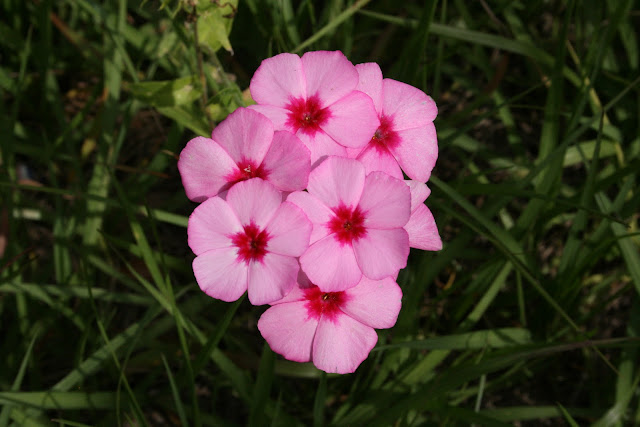Friday, May 31, 2013
Roadside (Annual) Phlox - Phlox drummondii
Roadside phlox is an annual that is not native to Florida, but widely planted on roadsides throughout the northern half of the state. It actually is native to Texas, but it thrives in well-drained sunny areas and, thus, makes an excellent roadside wildflower. It is a difficult landscape addition, however, because it is an annual and, like all members of this genus, its seeds "explode" when the seed capsules ripen and next year's phlox plants end up everywhere in the landscape except where they started.
Roadside phlox germinates in early spring and reaches its mature height of about 12 inches by late spring. Individual plants are thin and rather weak-stemmed. Leaves are linear and yellow-green in color. This is not a showy species for its foliage or when planted alone. In mass, however, it is spectacular.
Flowers come in a wide range of colors - from white to deep crimson, but most are a shade of pink, often with a contrasting center. All phlox are good nectar sources for butterflies and this species is no exception. Flowering occurs over a period of about a month, the plants soon wither and die by fall.
Florida's native phlox are perennials and these make superior landscape plants. Roadside phlox, however, is a superior choice for roadsides as it rapidly colonizes open areas and thrives in the sunny, often-dry conditions found on most roadways. Because of this, it is widely seeded by state highway staff involved with Florida's roadside beautification projects. It can't be missed if you travel anywhere in north Florida during April-June.
If you wish to try it in a landscape, use it in large planting beds where it can move about over the years, give it open, sunny conditions, and do not mulch it. I have had very limited success with it as a mixed wildlower garden specimen as it truly looks best when it can be massed and its annual nature and its method of reseeding make it impossible to mass over time unless it is used in a setting much like those found along roadsides.
Goldenmane Coreopsis - Coreopsis basalis
Goldenmane coreopsis (Coreopsis basalis) is the wildflower featured on the state wildflower license plate, but it is not native to Florida. The state's legislators adopted the genus, Coreopsis, as the state wildflower, not this individual species, and someone apparently decided that this species was the showiest of the group... It's hard to take exception to that as the rich yellow ray petals are beautifully contrasted near the center disk flowers by a deep maroon "V"-shaped pattern.
Goldenmane coreopsis is actually a western wildflower that occurs naturally in plains, pastures and prairies as well as in disturbed areas throughout the Deep South from Texas to the Carolinas. It is widely planted for the color it lends mixed wildflower plantings. In Florida, it is frequently mixed with other wildflower seed and used for highway beautification projects in north Florida. The photos above were taken in mid-May in Citrus County.
Goldenmane coreopsis is an annual and persists in open habitats and in places that undergo slight disturbance, allowing its seed to make good soil contact and germinate. Growth is rapid from early spring and flowering occurs by late spring. Flowers are produced into mid-summer and the plants wither by early fall.
This is a rather short, broad-spreading species. Most plants reach a mature height of about 12-18 inches, though the flower stalks may stand a foot taller. The plants are 12 inches across and the many basal leaves are deeply dissected.
Goldenmane coreopsis prefers sunny well-drained sites. It fails rapidly if the soil remains wet for long. I have not had much success with this species at my home in Pinellas County, and suspect it is best used only in the northern 1/3 of the state.
There is some dispute among taxonomists regarding its nativity. The vast majority do not consider it native, but a few argue that it should be considered native in the far western counties of the Panhandle. Regardless, it is widely planted on roadsides and, thus, widely encountered. The seed is also available should you decide to add it to your landscape. Just make sure you give it conditions that will allow it to reseed.
Subscribe to:
Posts (Atom)






